Ware C. Information Visualization: Perception for Design
Подождите немного. Документ загружается.

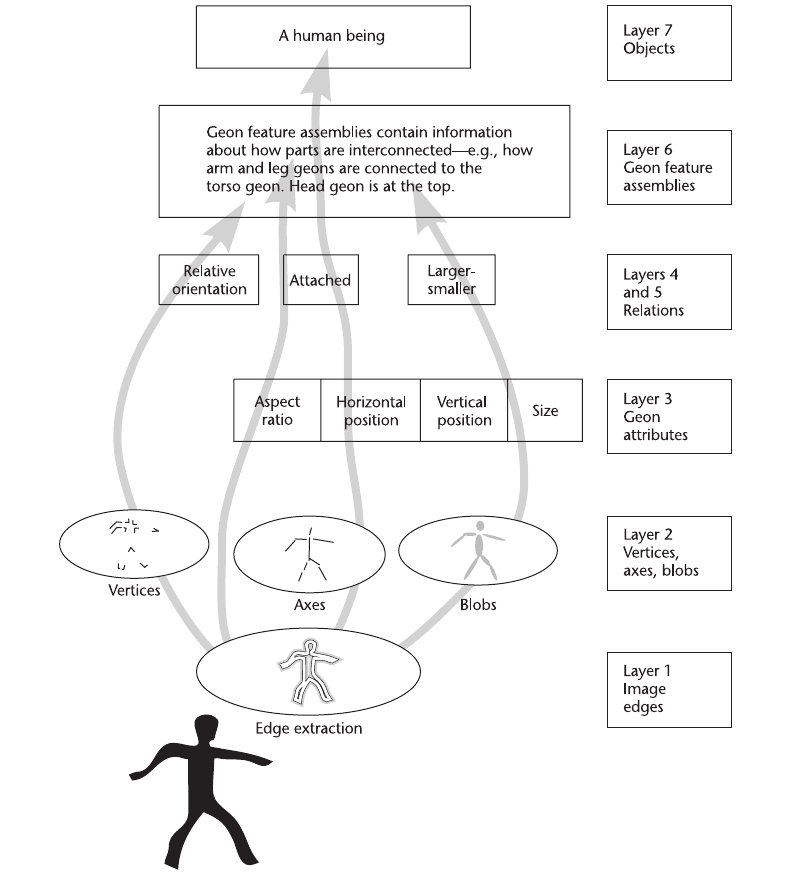
234 INFORMATION VISUALIZATION: PERCEPTION FOR DESIGN
Figure 7.4 A simplified view of Hummel and Biederman’s (1992) neural-network model of form perception.
ARE7 1/20/04 5:57 PM Page 234
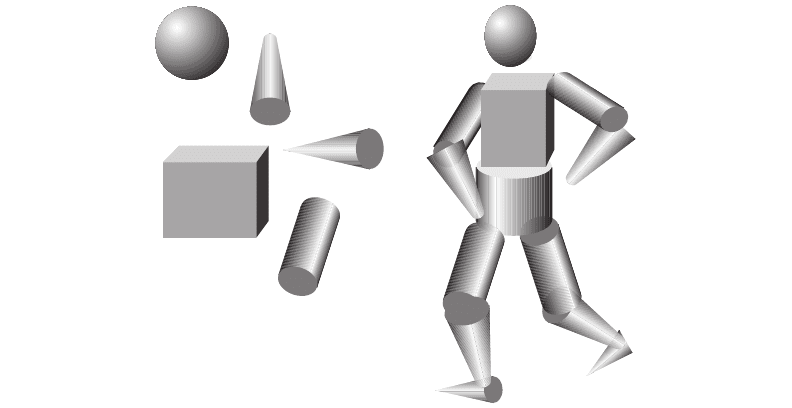
silhouettes that are easily recognizable; think of a teapot, a shoe, a church, a person, or a violin.
These canonical silhouettes are based on a particular view of an object, often from a point at
right angles to a major plane of symmetry. Figure 7.6 illustrates canonical views of a teapot and
a person.
David Marr suggested ways in which the brain might use silhouette information to extract
the structures of objects (Marr, 1982). He argued that “buried deep in our perceptual machin-
ery” are mechanisms that contain constraints determining how silhouette information is inter-
preted. Three rules are embedded in this perceptual machinery:
1. Each line of sight making up a silhouette grazes the surface exactly once. The set of
such points is the contour generator. The idea of the contour generator is illustrated in
Figure 7.7.
2. Nearby points on the contour of an image arise from nearby points on the contour
generator of the viewed object.
3. All the points on the contour generator lie on a single plane.
Under Marr’s default assumptions, contour information is used in segmenting an image into
its component solids. Marr and Nishihara (1978) suggested that concave sections of the silhou-
ette contour are critical in defining the ways different solid parts are perceptually defined. Figure
7.8 illustrates a crudely drawn animal that we nevertheless readily segment into head, body, neck,
Visual Objects and Data Objects 235
Figure 7.5 According to Biederman’s geon theory, the visual system interprets 3D objects by identifying 3D
component parts called geons.
ARE7 1/20/04 5:57 PM Page 235
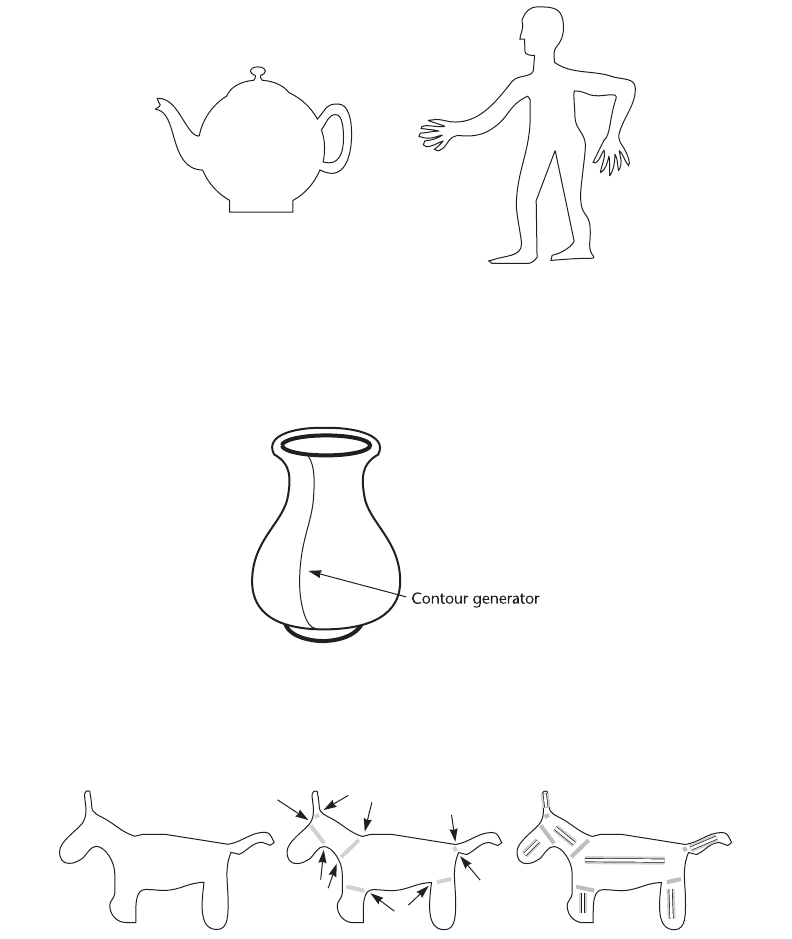
236 INFORMATION VISUALIZATION: PERCEPTION FOR DESIGN
Figure 7.6 Many objects have canonical silhouettes, defined by the viewpoints from which they are most easily
recognized. In the case of the man, the overall posture is unnatural, but the component parts—hands,
feet, head, and so on—are all given in canonical views.
Figure 7.7 According to Marr, the perceptual system makes assumptions that occluding contours are smoothly
connected and lie in the same plane. Adapted from Marr (1982).
Figure 7.8 Concave sections of the silhouette define subparts of the object and are used in the construction of a
structural skeleton. Adapted from Marr and Nishihara (1978).
ARE7 1/20/04 5:57 PM Page 236

legs, and so on. Marr and Nishihara also suggested a mechanism whereby the axes of the parts
become cognitively connected to form a structural skeleton.
One of the consequences of structural theories of perception is that certain simplified views
should be easier to read. There are practical advantages to this. For example, a clear diagram
may sometimes be more effective than a photograph. This is exactly what Ryan and Schwartz
(1956) showed when they found that a hand could be perceived more rapidly in the form of a
simplified line drawing than in the form of a photograph (see Figure 7.9).
But this result should not be overgeneralized. Other studies have shown that time is required
for detailed information to be perceived (Price and Humphreys, 1989; Venturino and Gagnon,
1992). Simplified line drawings may be most appropriate only when rapid responses are required.
Although image-based theories and structure-based theories of object recognition are usually
presented as alternatives, it may be that both kinds of processes occur. If geons are extracted
based on concavities in the silhouette, certain views of a complex object will be much easier to
recognize. Further, it may well be that viewpoint-dependent aspects of the visual image are stored
in addition to the 3D structure of the object. Indeed, it seems likely that the brain is capable of
storing many kinds of information about an object or scene if they have some usefulness. The
implication is that even though 3D objects in a diagram may be more effective in some cases,
care should be taken to provide a good 2D layout.
Faces
Faces are special objects in human perception. Infants learn about faces faster than other objects.
It is as if we are born with visual systems primed to learn to recognize important humans,
such as our own mothers (Morton and Johnson, 1991; Bruce and Young, 1998; Bushnell et al.,
1989). A specific area of our brains, the right middle fusiform gyrus, is especially important in
face perception (Puce et al., 1995; Kanwisher et al., 1999; Kanwisher et al., 1997). This area is
Visual Objects and Data Objects 237
Figure 7.9 A photograph of a hand and a simplified line drawing of the hand. Ryan and Schwartz (1956) showed that
a cartoon image was recognized more rapidly than a photograph.
ARE7 1/20/04 5:57 PM Page 237
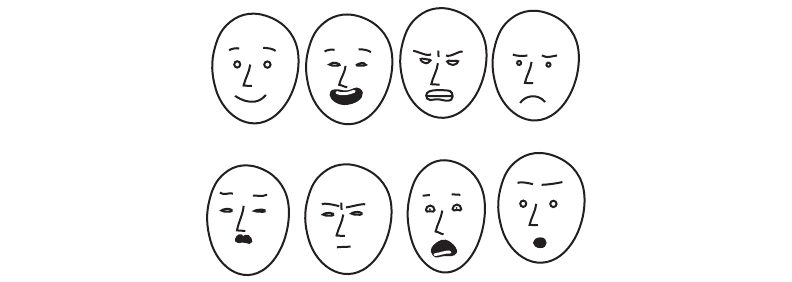
also useful for recognizing other complex objects, such as automobiles; although it is not essen-
tial as a Volkswagen detector, we cannot recognize faces without it.
Faces have an obvious importance in communication, because we use facial expression to
communicate our emotion and degree of interest. Cross-cultural studies by Paul Ekman and
coworkers strongly suggests that certain human expressions are universal communication signals,
correctly interpreted across cultures and social groups (Ekman and Friesen, 1975; Ekman, 2003).
Ekman identified six universal expressions: anger, disgust, fear, happiness, sadness and surprise.
These are illustrated in Figure 7.10, along with determination and elation (a variation on hap-
piness). The motion of facial features is also important in conveying emotion. Animated images
are necessary to convey a full range of nuanced emotion; it is especially important to show motion
of the eyebrows (Basilli, 1978; Sadr et al., 2003).
Facial expressions are produced by the contractions of facial muscles. The facial action
coding system (FACS) is a widely applied method of measuring and defining groups of facial
muscles and their effect on facial expression (Ekman et al., 1988). The eyebrows and mouth are
particularly significant in emotion signaling, but the shape of the eyes is also important. There
is evidence that false smiles can be distinguished from true smiles from the particular expression
around the eyes that occurs with contraction of a muscle that orbits the eye (Ekman et al., 1988;
Ekman, 2003). This muscle contracts with true smiles but not with false ones. According
to Ekman (2003) it is difficult, if not impossible, to control this voluntarily and thus fake a
“true” smile.
The main application of FACS theory in computer displays has been in the creation of
computer avatars that convey human emotion (Kalra et al., 1993; Ruttkay et al., 2003). Appro-
priate emotional expression may help make a virtual salesperson more convincing. In computer-
aided instruction, the expression on a human face could reward or discourage.
238 INFORMATION VISUALIZATION: PERCEPTION FOR DESIGN
Figure 7.10 Happiness, elation, anger, sadness, disgust, determination, fear, surprise.
ARE7 1/20/04 5:57 PM Page 238
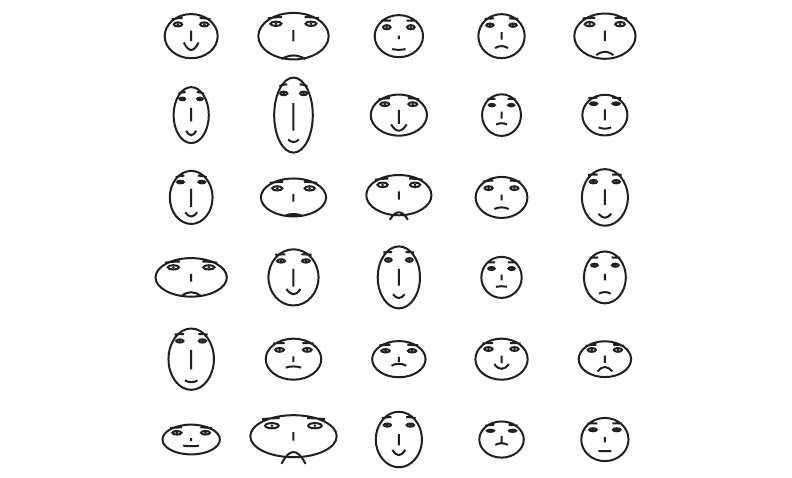
The Object Display and Object-Based Diagrams
Wickens (1992) is primarily responsible for the concept of an object display as a graphical device
employing “a single contoured object” to integrate a large number of separate variables. Wickens
theorized that mapping many data variables onto a single object will guarantee that these vari-
ables are processed together, in parallel. This approach, he claimed, has two distinct advantages.
The first is that the display can reduce visual clutter by integrating the variables into a single
visual object. The second is that the object display makes it easier for an operator to integrate
multiple sources of information.
Among the earlier examples of object displays are Chernoff faces, named after their inven-
tor, Herman Chernoff (1973). In this technique, a simplified image of a human face is used as a
display. Examples are shown in Figure 7.11. To turn a face into a display, data variables are
mapped to different facial features, such as the length of the nose, the curvature of the mouth,
the size of the eye, the shape of the head, etc. There are good psychological reasons for choos-
ing what might seem to be a rather whimsical display object. Faces are probably the most impor-
tant class of objects in the human environment. Even newborn babies can rapidly distinguish
Visual Objects and Data Objects 239
Figure 7.11 Chernoff faces. Different data variables are mapped to the sizes and shapes of different facial features.
ARE7 1/20/04 5:57 PM Page 239
faces from nonfaces with scrambled features, suggesting that we may have special neural
hardware for dealing with faces. Jacob et al. (1976) carried out a classification task using a
series of displays that were progressively more objectlike. The displays included Chernoff
faces, tables, star plots, and the whisker plots described in Chapter 5. They found that
the more objectlike displays, including Chernoff face plots, enabled faster, more accurate
classification.
Chernoff faces have not generally been adopted in practical visualization applications. The
main reason for this may be the idiosyncratic nature of faces. When data is mapped to
faces, many kinds of perceptual interactions can occur. Sometimes the combination of
variables will result in a particular stereotypical face, perhaps a happy face or a sad face, and
this will be identified more readily. In addition, there are undoubtedly great differences in
our sensitivity to the different features. We may be more sensitive to the curvature of the mouth
than to the height of the eyebrows, for example. This means that the perceptual space of
Chernoff faces is likely to be extremely nonlinear. In addition, there are almost certainly many
uncharted interactions between facial features, and these are likely to vary from one viewer to
another.
Often, object displays will be most effective when the components of the objects have a
natural or metaphorical relationship to the data being represented. For example, Figure 7.12
illustrates how a storage vessel in a chemical plant might be represented using both a conven-
tional bar chart and a customized object display. The variables in the object diagram are repre-
sented as follows:
•
Size of cylinder represents tank capacity.
•
Height of liquid represents volume of material stored.
•
Texture of liquid represents the chemical composition.
•
Color of liquid represents liquid temperature.
•
Diameter of pipe represents outflow capacity.
•
Status of the valve and thickness of the outgoing fluid stream represent rate at which
liquid is being drawn from the tank.
In this example, the object display has a number of clear advantages. It can reduce accidental
misreadings of data values. Mistakes are less likely because components act as their own
descriptive icons. In addition, the structural architecture of the system and the connections
between system components are always visible, and this may help in diagnosing the causes
and effects of problems. Conversely, the disadvantage of object displays is that they lack gener-
ality. Each display must be custom-designed for the particular application and, ideally, should be
validated with a user population to ensure that the data representation is clear and properly inter-
preted. This requires far more effort than displaying data as a table of numbers or a simple bar
chart.
240 INFORMATION VISUALIZATION: PERCEPTION FOR DESIGN
ARE7 1/20/04 5:57 PM Page 240

The Geon Diagram
Biederman’s geon theory, outlined earlier, can be applied directly to object display design. If cylin-
ders and cones are indeed perceptual primitives, it will make sense to construct diagrams using
these geon elements. This should make the diagrams easy to interpret if a good mapping can be
found from the data to a geon structure. The geon diagram concept is illustrated in Figure 7.13(a).
Geons are used to represent the major components of a compound data object, whereas the archi-
tecture of the data object is represented by the structural skeleton linking the geons. The size of
a geon becomes a natural metaphor for the relative importance of a data entity, or its complex-
ity or relative value. The strength of the connections between the components is given by the
necklike linking structures. Additional attributes of entities and relationships can be coded by
coloring and texturing them.
We evaluated the geon diagram concept in a comparison with Unified Modeling Language
(UML) diagrams (Irani et al., 2001). UML is a widely used, standardized diagramming notation
for representing complex systems. Equivalent diagrams were constructed by matching geon ele-
ments to UML elements (see Figure 7.13). We found that when the task involved rapid identifi-
cation of substructures in a larger diagram, participants performed both faster and with only half
the errors using the geon diagrams. Another experiment showed that geon diagrams were easier
to remember.
In Biederman’s theory, surface properties of geons, such as their colors and textures, are sec-
ondary characteristics. This makes it natural to use the surface color and texture of the geon to
represent data attributes of a data object. The important mappings between data and a geon
diagram are as follows:
Visual Objects and Data Objects 241
Figure 7.12 Two representations of the same data. The object diagram on the right combines six variables in an
easily interpreted, cohesive representation.
ARE7 1/20/04 5:57 PM Page 241
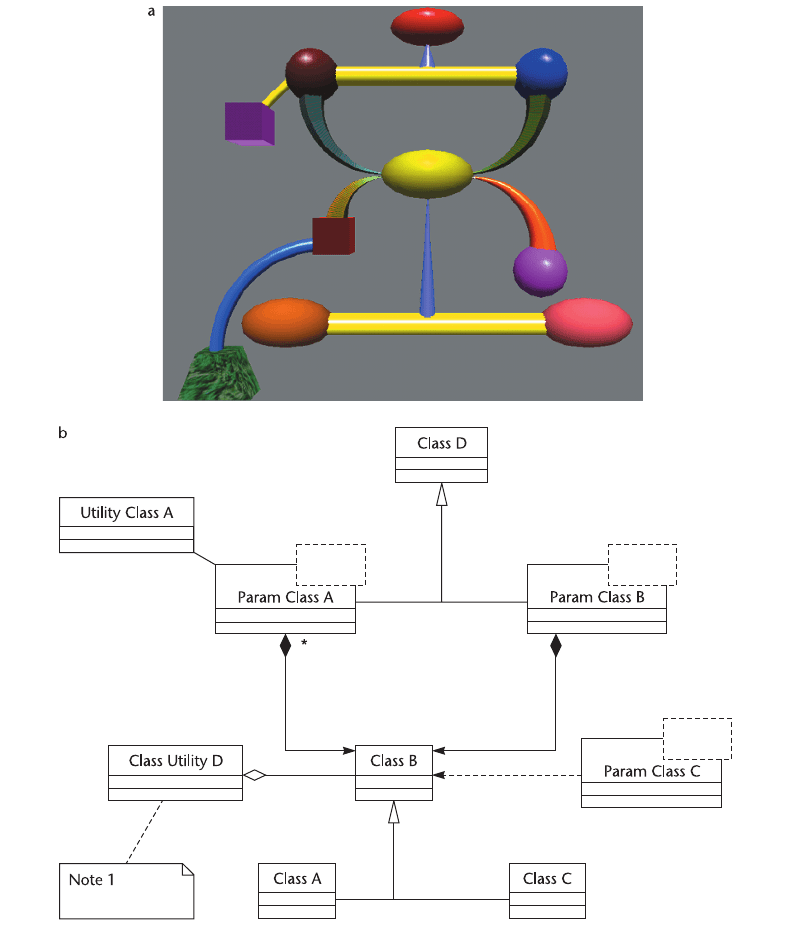
242 INFORMATION VISUALIZATION: PERCEPTION FOR DESIGN
Figure 7.13 (a) A geon diagram constructed using a subset of Biederman’s geon primitives. The primitive elements
can also be color-coded and textured. (b) A Unified Modeling Language (UML) equivalent.
ARE7 1/20/04 5:57 PM Page 242
Major components of Æ Geons
a complex data object
Architectural links between Æ Limbs consisting of elongated geons—connections
data object components between limbs reflect architectural structure of data
Minor subcomponents Æ Geon appendices—small geon components attached to larger geons
Component attributes Æ Geon color, texture, and symbology mapped onto geons
Although the geon diagram is a 3D representation, there are reasons to pay special attention to
the way it is laid out in 2D in the x,y plane. As discussed earlier, some silhouettes are especially
effective in allowing the visual system to extract object structure. Thus, a common-sense design
rule is to lay out structural components principally on a single plane. A diagramming method
resembling the bas-relief stone carvings common in classical Rome and Greece may be optimal.
Such carvings contain careful 3D modeling of the component objects, combined with only limited
depth and a mainly planar layout.
Abstract semantics may be expressible, in a natural way, through the way geons are inter-
connected. In the everyday environment, there is meaning to the relative positioning of objects
that is understood at a deep, possibly innate level. Because of gravity, above is different from
below. If one object is inside another, it is perceived as either contained by that other object or
a part of it. Irani et al. (2001) suggested that the semantics inherent in the different kinds of rela-
tionships of real-world objects might be applied to diagramming abstract concepts. Based on this
idea, the researchers developed a set of graphical representations of abstract concepts. Some of
the more successful of these mappings are illustrated in Figure 7.14 and listed as follows.
•
Sometimes we wish to show different instances of the same generic object. Geon theory pre-
dicts that having the same shape should be the best way of doing this. Geon shape is domi-
nant over color, which is a secondary attribute. Thus the elbow shapes in Figure 7.14(a) are
seen as two instances of the same object, whereas the two green objects are not.
•
Having an object inside another transparent object is a natural representation of a part-of
relationship. The inside objects seem part of the outside objects, as in Figure 7.14(b).
•
One object above and touching another, as shown in Figure 7.14(c), is easily understood
as representing a dependency relationship.
•
A thick bar between two objects is a natural representation of a strong relationship between
two objects; a thinner, transparent bar represents a weak relationship. See Figure 7.14(d).
Perceiving the Surface Shapes of Objects
Not all things in the world are made up of closed, discrete components like geons. For example,
there are undulating terrains that have no clearly separable components. Although to some extent
Visual Objects and Data Objects 243
ARE7 1/20/04 5:57 PM Page 243
